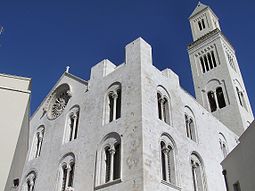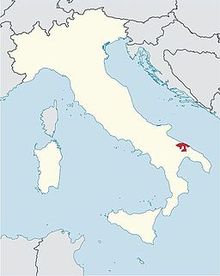Roman Catholic Archdiocese of Bari-Bitonto
Roman Catholic archdiocese in Italy From Wikipedia, the free encyclopedia
Roman Catholic archdiocese in Italy From Wikipedia, the free encyclopedia
The Archdiocese of Bari-Bitonto (Latin: Archidioecesis Barensis-Bituntina) is Metropolitan Latin archdiocese of the Catholic Church in the administrative Bari province, Puglia (Apulia) region, southeastern Italy (the 'Heel'), created in 1986, when the historical diocese of Bitonto was subsumed in the Archdiocese of Bari.[1][2]
Archdiocese of Bari-Bitonto Archidioecesis Barensis-Bituntina | |
|---|---|
 Cathedral in Bari | |
| Location | |
| Country | Italy |
| Ecclesiastical province | Bari-Bitonto |
| Statistics | |
| Area | 1,264 km2 (488 sq mi) |
| Population - Total - Catholics | (as of 2015) 749,141 736,801 (98.4%) |
| Parishes | 126 |
| Information | |
| Denomination | Catholic Church |
| Rite | Roman Rite |
| Established | 4th Century |
| Cathedral | Cattedrale-Basilica di S. Maria |
| Co-cathedral | Concattedrale di Maria SS. Assunta |
| Secular priests | 196 (diocesan) 155 (Religious Orders) 76 Deacons |
| Current leadership | |
| Pope | Francis |
| Archbishop | Giuseppe Satriano |
| Map | |
 | |
| Website | |
| www.arcidiocesibaribitonto.it | |

The first known bishop of Bari was said to have been Gervasius,[3] or Gerontius,[4] who, in 347, was present at the Council of Sardica. Gerontius, however, was actually from the city of Beroea in Macedonia,[5] and there is no record of Gervasius, or of Bari, at the Council of Sardica.
In 530 bishop Peter is said to have held the title of Metropolitan under Epiphanius, bishop of Constantinople & Ecumenical Patriarch, though there is no reliable record of this. In the 6th century the bishops of Apulia were directly subject to the Roman pontiff. It was not until after the Byzantine Patriarchs regained their control of Calabria and Apulia after the decree of Leo I that Bari became an archbishopric, and that situation changed when the Normans invaded Calabria and Apulia in the 11th century and returned the Churches of Calabria and Apulia to the Roman obedience.[6]
In 780 bishop Leontius was present at the Second Council of Nicaea.[7]
In the ninth century the Saracens laid waste Apulia, destroyed the city of Canosa (Canusium) and captured Bari.[8] In 841, however, the Byzantine army reconquered Bari, and in 844 Bishop Angelarius, Bishop of Canosa, brought to Bari the relics of Rufinus, Memorus, and Sabinus of Canosa, which he had rescued from the ruins of Canosa. Pope Sergius II conferred on Angelarius the title of Bishop of the two dioceses of Bari and Canosa, a title which the archbishops of Bari retained up to 1986.[9] In 988 the Saracens descended upon Bari, depopulated the countryside and took men and women to Sicily as captives. In 991 Count Atto fought against the Saracens at Taranto, where he and many men of Bari fell. In 1002 Bari was besieged from 2 May until October, when they were rescued by Pietro Orseolo (II), the Doge of Venice.[10]
In 933 Pope John XI granted the bishops of Bari the use of the pallium. It seems that the bishops were dependent on the Eastern Ecumenical Patriarch until the 10th century. Archbishop Giovanni II (952) was able to withdraw from this influence, refusing to accept the prescriptions of the patriarch concerning liturgical points. All connection with the Eastern Churches was finally severed during the eleventh century, as Bari became a direct ecclesiastical dependency of Rome. So before the 10th c was over, the top ranking Orthodox episcopal dignitary throughout Byzantine Italy, became the archbishop of Melfi, in spite of Bari remaining the center of Byzantine authority in the area, as the seat of the katepano of Italia until the capture of the city by the Normans in 1071.
Ironically the archbishop of Bari that irreversibly distanced his see from Byzantium, was Byzantius (1025), who obtained from the pope the privilege of consecrating his suffragans.[citation needed] He also began the construction of the new cathedral, which was continued by his successors, Nicolo (1035), Andreas (1062), and Elias (1089) of the Benedictine Order.
By contrast to Bishop Bisanzio's Catholicism affections, Andreas, the archbishop from 1062 to at least 1066, kept an eye to the roots of his Faith, for example journeying to Constantinople, and at some point even converting to Judaism. Archbishop Andreas then fled to Muslim-dominated Egypt, where he eventually died in 1078.[11] Remarkably, the next archbishop Urso (1080–1089)[12] was captured by the Muslim forces and converted to Islam.[13]
In 1087 some sailors from Bari, on their return from the East, brought with them the relics of Saint Nicholas, bishop of Myra. Roger Borsa, the Norman duke of Apulia, built a church, the Basilica of San Nicola to house his remains. This church became the object of pilgrimage. In 1113, the Baresi rejected the rule of Constance, the wife of Bohemond I of Antioch and made the archbishop Riso their leader instead. In return Constance seized the cathedral of Canosa and only by intervention of Pope Paschal II the bishop was allowed back into his own cathedral. Upon reconciliation and bettering relations between Constance and Riso the bishop was killed.[14]
In the reorganization of the dioceses of the Kingdom of Naples, in accordance with the articles of the Concordat of 1818 between Pope Pius VII and King Ferdinand I of the Two Sicilies,[15] the diocese of Bitetto was suppressed and made a part of the Diocese of Bari. The suffragan sees under Bari historically were: the diocese of Conversano, diocese of Ruvo, and diocese of Bitonto.[16]
In the Apostolic Constitution Qui Beatissimo of 20 October 1980, Pope John Paul II suppressed the ecclesiastical province of Trani, and created the ecclesiastical province of Bari, with the Archbishop of Bari as its Metropolitan.[17] The province of Bari thus included: Bari, Conversano, Ruvo, Bitunto, Trani and Baroli (Barletta), Bisceglie and Andria, Gravina, Melphi, Giovinazzo and Terlizzi, Monopoli, and the prelatures of Altamura and Aquaviva. On 30 September 1986 the independent diocese of Bitunto was suppressed and united with the diocese of Bari, and its bishop, Andrea Mariano Magrassi (1982-1986), who had been Archbishop of Bari-Canosa since 1977, was named Archbishop of the united diocese of Bari-Bitonto.[18]
This section needs expansion. You can help by adding to it. (June 2017) |
Erected: by 5th Century
Latin Name: Barensis
Elevated: 6th Century to Metropolitan See
Latin Name: Barensis (-Canusina)
30 September 1986 United with the Diocese of Bitonto to form the Archdiocese of Bari-Bitonto
Latin Name: Barensis-Bituntina
Seamless Wikipedia browsing. On steroids.
Every time you click a link to Wikipedia, Wiktionary or Wikiquote in your browser's search results, it will show the modern Wikiwand interface.
Wikiwand extension is a five stars, simple, with minimum permission required to keep your browsing private, safe and transparent.